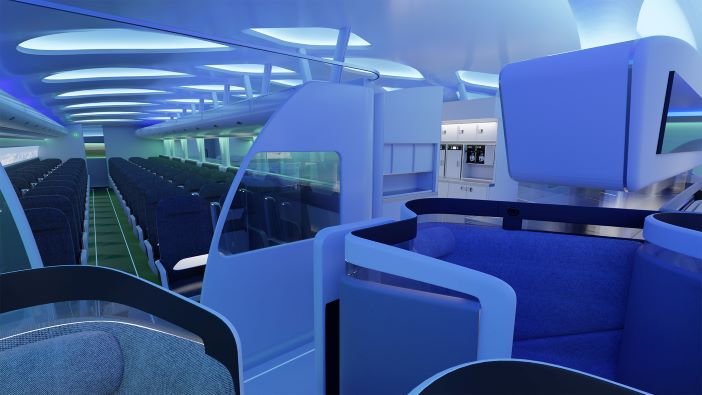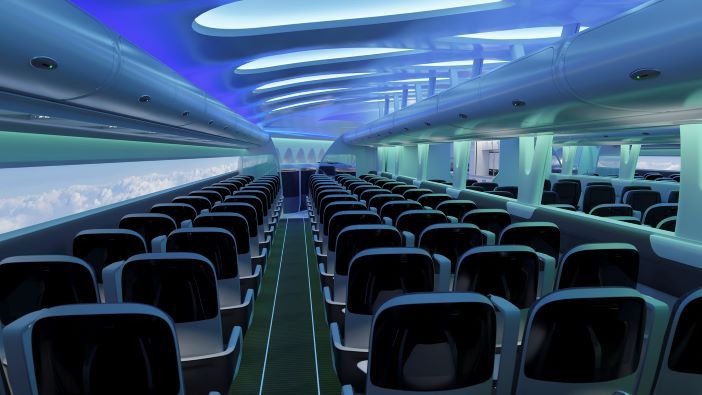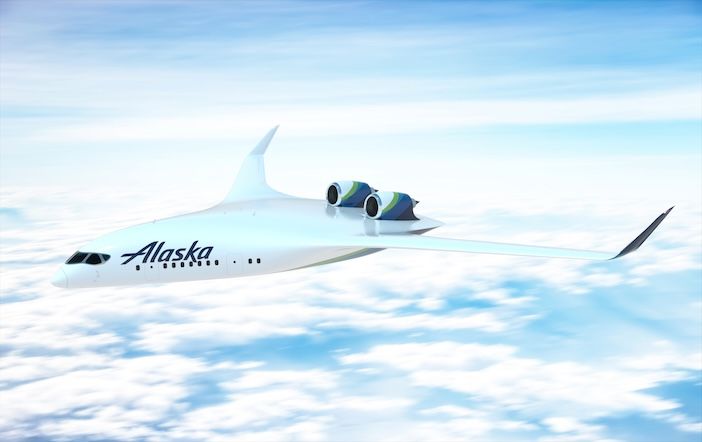JetZero, a company developing the first commercial blended wing body (BWB) airplane as an alternative to today’s conventional ‘tube-and-wing’ designs, has found a slightly unexpected investor in the form of Alaska Airlines, a carrier with a conservative fleet of various Boeing 737 and Embraer 175 aircraft.
Alaska Airlines is the first airline to invest in JetZero’s Series A funding round, made through Alaska Star Ventures (ASV), the airline’s investment arm set up to identify and enable technologies that can help Alaska Airlines reach its ambitious goal of net-zero carbon emissions by 2040.
JetZero’s BWB could fit the bill for ASV’s aims, as the company is aiming to launch the aircraft in 2030 with 100% SAF compatibility, with claims of up to 50% reduced fuel burn, lower carbon emissions, and reduced noise as the engines are mounted on top of the aircraft in semi-buried engine nacelles. ASV’s investment also includes options for orders of the JetZero BWB aircraft.
If the options were taken up for Alaska Airlines, the BWB passenger experience would be rather different to today’s tube designs. Having the wings and fuselage combined in a single smooth shape with no tailfin not only reduces aerodynamic drag, but also opens up a broad, spacious interior that enables innovative seating arrangements.

JetZero proposes a ‘middle market’ configuration with around 200-250 seats, with overhead bin space for every passenger’s carry-on bag. A strong feature of the JetZero is that the aircraft could be integrated seamlessly into existing airport infrastructures, as its single-deck design fits existing runways and gates.
JetZero initially worked with the Factorydesign studio to maximise the potential opened up by the internal volume of the BWB. According to Factorydesign its aircraft interior concepts for JetZero were inspired by regenerative design principles more commonly used in ultra-modern building design.
In basic terms, this means that the concept cabin structures are designed and optimised to provide strength where it is needed, which can open up cellular gaps appear where strength is not needed, saving weight. This approach means the cabin could be lit by overhead and front side windows, with many apertures in-between the structural elements that flood the cabin with light and space.
You can see a gallery of the Factorydesign cabin designs HERE.
In terms of the layout of passenger accommodations (LOPA), the broad cabin space would enable multiple seating areas to be positioned within the centre of the aircraft. The initial cabin concept is shown here with relatively standard aircraft seat products, but the design team is continuing to explore ways to completely redefine the commercial passenger flying experience. The interior space would also give designers more flexibility in working with airlines on their preferred galley, lavatory and seating arrangements.
The space is certainly large and would create a great feeling of space. Almost too big a feeling if not carefully considered, and indeed Factorydesign’s renderings show ideas of how to split the space into zones and more intimate spaces.

Peter Tennent, director of Factorydesign said of the cabin concepts. “Aircraft technology has advanced hugely over the last 60 years; however, the opportunities for improved efficiency are reducing. The same is happening in cabin interiors, as decades of attention means opportunities in tube and wing aircraft to create unique passenger experiences are becoming increasingly elusive. Significant and beneficial step-change to the passenger flying experience will only come with a revolution in aircraft, and the JetZero blended wing aircraft is exactly that.”
The design teams have also been investigating how the latest high-definition displays could be used to form cabin sidewall panels, on which images could be projected, such as window frames with a view, or full-length animated panoramic views of the passing sky.

2030 seems an ambitious target launch date for FlyZero, but it does have some impressive development partners – the likes of the United States Air Force, NASA, and the FAA. If and when it does take to the skies, the aircraft will certainly be a landmark moment in commercial aviation.
As Tom O’Leary, CEO and co-founder of JetZero said of the aircraft, “Of all the great new technologies in work, the BWB design delivers the biggest impact by far. Airlines will see immediate benefit in cost savings, dramatically lower emissions and improved customer experience, compared to airplanes flying today. We’re thrilled to welcome Alaska to our team of innovators, and our belief that this aircraft will reshape aviation.”
Across the Atlantic, a consortium is looking at how the net-zero passenger experience could develop for larger-fuselage aircraft. You can find out more about the FlyZero cabins HERE.
An opportunity to see the latest developments with the JetZero aircraft is coming up. A public unveiling of the aircraft is planned for the evening of Sunday, 27th October in Long Beach, California, the night before the opening of APEX Global Expo.






